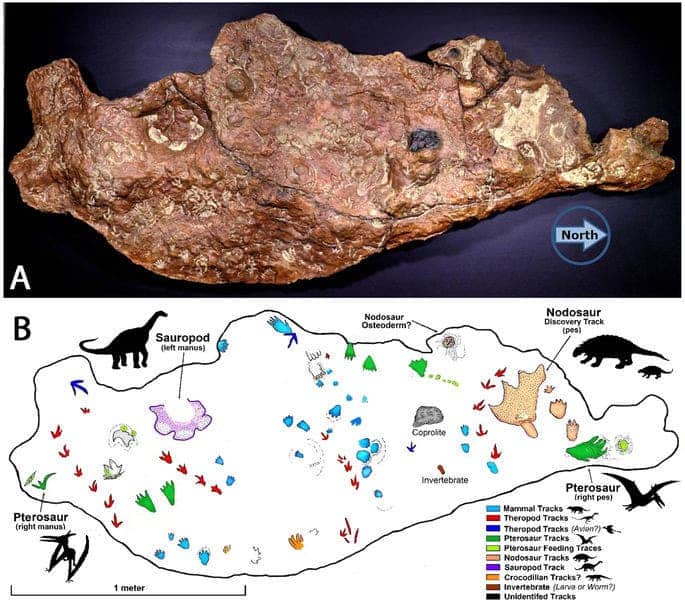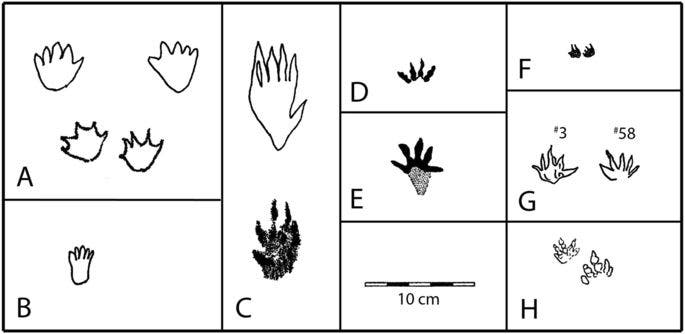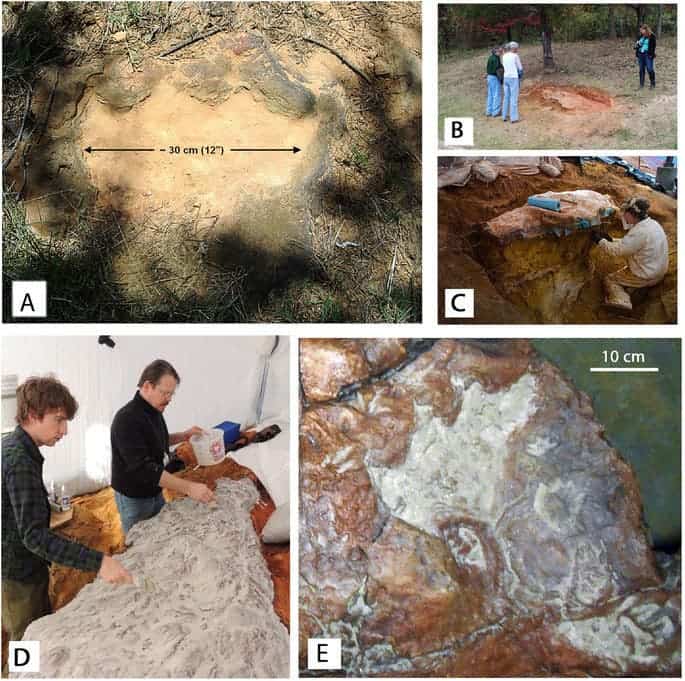
Inside the grounds of NASA’s Goddard Spaceflight Center in Maryland, one fortunate fossil hunter came across a rare and amazing find. While at lunch with his wife, Ray Stanford, an amateur paleontologist, saw a slab protruding out of the ground. Upon closer inspection, it proved to be a section of a 100-million-year-old track comprising both dinosaur and tiny mammal footprints.
A busy crossroad
The 8.5-foot-long (2.5-meter) slab of sandstone features a diverse assortment of tracks, small and large, belonging to numerous ancient species, now long extinct. Inside a very concentrated surface area, Lockley found footprints belonging to a juvenile sauropod (the famous long-necked plant-eating dinosaur), a nodosaur (an armored plant-eater the size of an elephant) and its baby which was tagging along, four theropods (bipedal saurischian dinosaurs, which includes T. Rex), pterosaurs (flying reptiles of the extinct clade or order Pterosauria), but also little early-mammal tracks — perhaps the latter quickly scattered on the muddy terrain to escape becoming lunch for the theropods.

Then and now, the Washington DC area where the tracks were found has been a swamp. A perfect sequence of events preserved the footprints of all these diverse animals etched into the mud — still an amazing picture millions of years later.
The mammal tracks are particularly intriguing. They look like very small pads and, though they may not look like much, are incredibly valuable to researchers. Not that many mammal fossils have been retrieved from that era and, as far as footprints go, these are usually single impressions on a stray piece of rock. But the Maryland slab contains pairs of prints that suggest the mammal was in a sitting position. Scientists named the animals that left their mark in the limestone Sederipes goddardensis, which literally means “sitting footprint.”
The dinosaur age has met the space age at NASA Goddard. A slab of sandstone discovered at Goddard contains at least 70 mammal & dinosaur tracks from more than 100 million years ago: https://t.co/uc2iJaddv0 pic.twitter.com/NgCSDWXuLv
— NASA Goddard (@NASAGoddard) January 31, 2018
The discovery could not have been timed any better. The site where the tracks were found — a parking lot and hill — was about to be cleared to make way for a new $31 million office building. Before any construction began at the site, officials brought in Compton Tucker, who is a Goddard scientist with expertise in geophysical surveys. Tucker had previously investigated buried ruins at archeological sites without scooping an ounce of soil. Using ground-penetrating radar, Tucker could see what was lying beneath his feet, like X-raying the ground, and found the rest of the sandstone pieces. After being told where to dig, an army of volunteers dug up the designated areas. Ultimately, no other piece proved to be as interesting as the one Stanford had first identified. Sometimes, you just get lucky like this.
“The concentration of mammal tracks on this site is orders of magnitude higher than any other site in the world,” said Martin Lockley, paleontologist with the University of Colorado, Denver, a co-author on the new paper. “I don’t think I’ve ever seen a slab this size … where you have over 70 footprints of so many different types. This is the mother lode of Cretaceous mammal tracks.”

This was in 2012. Meanwhile, scientists like Stephen Godfrey, curator of paleontology at the Calvert Marine Museum in Solomons, Maryland, cleaned the rock and made a fiberglass cast of it. Stanford had one cast delivered to his basement where would carefully study it. He was the one who identified that the four, small, raven-sized theropods were heading in the same direction, and doing so slowly, and that some tiny prints actually belong to early mammals — hunter and prey in the same picture. Stanford’s wife also identified a novel print — that of a pterosaur which her husband had missed. She is also a co-author of the paper published in the journal Scientific Reports.
In total, over 80 footprints have been mapped in the limestone slab. Stanford believes they were carved in the mud in a matter of hours on a typical day. All at a site known for its excellence in science, albeit in a totally different field — engineering and astrophysics. It just goes to show that there are amazing discoveries to be made. Often, they’re right under our noses. You just have to know where to look.
“It’s a time machine,” Stanford said in a statement. “We can look across a few days of activity of these animals and we can picture it. We see the interaction of how they pass in relation to each other. This enables us to look deeply into ancient times on Earth. It’s just tremendously exciting.”
Was this helpful?



